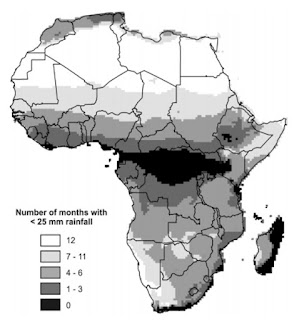I was drawn to writing a post on the link between water,
climate change and Africa by an article discussing international agreements regarding
climate change such as this year’s COP (Conference of the Parties) climate
summit. African countries will see some of the most severe climate changes
in the future with six of the ten countries most affected by greenhouse gases being located in Africa. This is all despite the fact that the continent
receives just 5% of global climate funding. On a more positive note, ‘every single African country has included adapting agriculture as part of their climate change strategies submitted to the United Nations Framework Convention on Climate Change (UNFCCC).’ Therefore this is not a question of
willingness but rather one of finance. To investigate this further I wish to
look into the funding behind agriculture in Africa to understand how it here
can adapted to changes in rainfall patterns, droughts, etc.
The news article highlights three main areas to target
investment to ensure the future of African agriculture. These are: better soil management, water control and climate-risk management. The first of these
is very important for maintaining high crop yields. Research has found that soil nutrient levels decrease with distance from water points. The areas close
to water points also had a lower soil salinity level. Salinity is a key
cause of land degradation; overly saline soil is unsuitable for growing the
majority of crops. This is another reason why droughts are especially damaging
for agricultural business as in addition to killing off crops, it can also
leave land unsuitable in the long term. A concerning statistic is that 65% of soils in Africa are likely to be degraded. This statistic combined with the
fact that climate change will likely cause further degradation suggests a
concerning future for all of Africa, especially those involved in the
agriculture sector. One idea is to plant crops that are natural fertilisers of
the soil such as chickpeas and lentils that add nitrogen. This simultaneously combats
the issue of degraded soils and sustains an income for farmers in the short
term. It is therefore an alternative to growing existing crops.
The second of these target areas for investment is water
management. Currently there is a lack of knowledge on irrigation water values in small-scale farming schemes. In the future, farmers will have to pay for the water they use and therefore the issue of water management is of
economic and environmental importance. It is extremely complicated to assess
the consumption of water for irrigation because there is a great variability between irrigation schemes and the type of crop grown. This makes it
difficult to estimate the overall dependence on water systems and therefore how
to control water resources. As well as improving the knowledge of irrigation
water demand, there are a number of techniques, such as drip fed irrigation,
which can be applied to reduce water consumption universally. Drip fed irrigation reduces water usage as the water is applied directly to the root of
the crop through a distribution system of pipes, meaning less water is lost
through evaporation and the minimum amount of water required can be added as
water flow can be controlled. This research and equipment however requires
funding and it reflects back on the key issue for African countries – funding.
 |
| Figure 1: Drip fed irrigation in Kenya |
Climate-risk management is the final area that requires
investment. This can involve the development of new crops such as climate-tolerant and disease-resilient varieties. In sub-Saharan Africa,
there will be a shortage of cereals in the near future if the status quo is
maintained. Insect resistant varieties of maize and cotton suitable for this area of Africa have increased crop yields. The use of
genetically-modified crops, especially drought-resistant varieties, could
reduce water consumption for irrigation as well as increasing the chance of
survival during periods of very low rainfall. Climate-risk management is the least
suitable of the three methods to implement across Africa because it would take
longer to implement than the other two methods mentioned earlier.
Overall, as a continent, Africa is fully committed to
mitigating the effects of climate change on the agriculture sector and have the
techniques available to achieve this that are suitable for this part of the
world. What they do lack however is the financial backing to implement such
projects and this is where the international community should be open to
helping African countries. Without financial support the future of agricultural
sectors across Africa is concerning, risking crop deaths and heavily degraded
land that is unusable for crops. It would leave people across Africa in an
extremely difficult situation.




